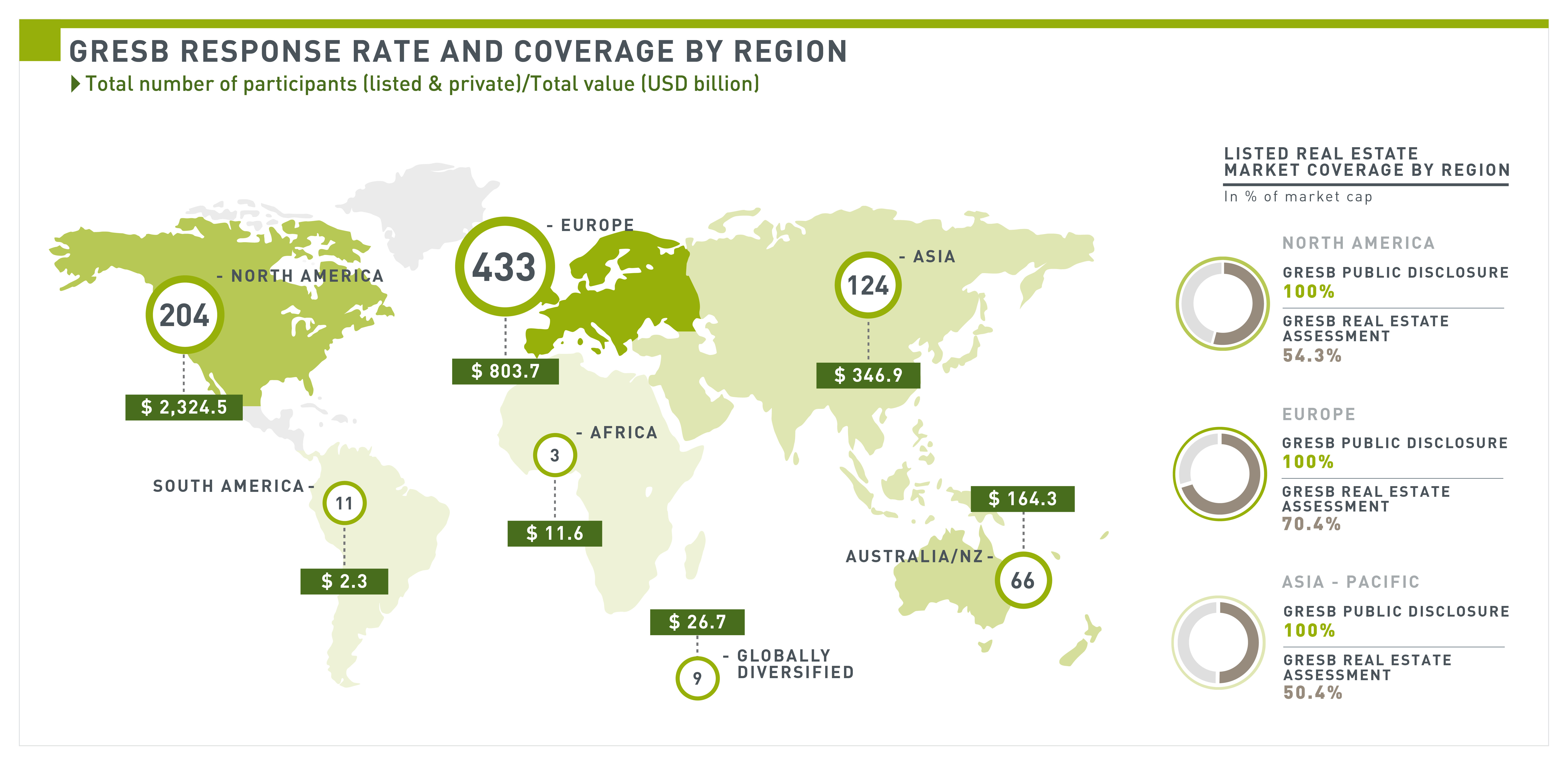October 2, 2017
The evolution of GRESB - Getting to business value
Last week, Quinn & Partners’ Tony Pringle was in New York City for the annual GRESB results release. Here he reports on GRESB’s continued growth and explains how your company can use the survey to create business value.
Eight years in: GRESB continues to gain momentum
GRESB – the Global Real Estate Sustainability Benchmark – has increased 20% annually since it launched in 2010. In 2017, 850 companies and funds participated, representing 77,000 assets and $3.7 trillion in real estate value.

Although North America still lags behind Europe in number of participants, it has almost three times the asset value, demonstrating that the assessment is well established in Canada and the US.
In public markets, GRESB participants represent the majority of market value, covering 54% of North America, 70% in Europe, and 50% in Asia-Pacific. To fill in the gaps, GRESB now scores non-participating companies based on publicly disclosed Environmental, social and governance (ESG) information. Although these scores are not as robust, they give investor members a full market picture. Including disclosure from non-participants also allows GRESB to compete with other ESG ranking organizations. Since GRESB’s suite of assessments also includes real estate debt and infrastructure, it provides investors a one-stop-shop for ESG data in real asset portfolios.
GRESB’s continued relevance is driven in large part by investors. GRESB is supported by 66 investor members, representing $17 trillion in assets under management – more than double the value of last year’s GRESB members. In a survey of these investor members, 94% stated they use GRESB data in their investment process, and two thirds stated they either mandate or strongly encourage participation from all the funds they invest in.
But transparency still trumps performance for investors: Only 35% of investor members set performance targets for GRESB, and these targets relate to participation or year-on-year improvement.
“The [GRESB] process makes us better.”
This was the opening statement from James Kennedy, Managing Director of Asset Management at JP Morgan Chase at last week’s results release. Kennedy’s view was echoed by the sector leaders, demonstrating that investors alone aren’t driving GRESB participation. Curiosity, competition and companies’ desire to find business value appear to be equally important.
This sentiment was echoed by the sector leaders, who provided examples of how they turn GRESB questions into business value. Prologis, who’s conversations around tenant engagement have led them to develop a customer sustainability advisory council, is a prime example of innovating GRESB questions into business value.
“Internal conversations initiated by GRESB participation have made Boston Properties a stronger, more purposeful organization.” – Ben Meyers, Manager of Sustainability at Boston Properties.
Checking off a box in the GRESB survey doesn’t deliver value – that comes from developing an approach and executing a program to address a material industry E, S or G topic. GRESB’s true value, then, lies in using the survey as a change management tool to spark internal discussions and action plans around topics such as sustainable development, health and wellness, climate risk and resilience and tenant and community engagement. These are issues that span across departments.
For example, conversations on industrial property data with one client led to collaboration between property management, leasing, communications and operations to engage industrial tenants and green the standard lease. As more companies strive for GRESB leadership and check off more boxes, differentiation comes with execution, not score.
The stages of GRESB – From GRESB NYC results presentations

What’s next: The assessment continues to evolve
“The test is getting harder” according to GRESB’s head of North America, Dan Winters. The leadership pack is getting more crowded as companies advance their practices and the assessment will change more in 2018 as a result.
Questions on sustainability management will dig deeper to identify companies with more sophisticated sustainability governance. Some of the questions from the voluntary health and wellness assessment will be integrated into the main survey. And there will be greater emphasis on providing property level performance data.
Recommendations for success
Having supported 12 GRESB submissions in 2017, with 10 Green Stars and one country leader, Quinn & Partners has learned a few tricks to improve score results and identify business value.
- Start early: Have a plan in place to get going as soon as the pre-survey is released in January
- Provide time to prepare for reporting for improved results: Give properties a pre-emptive head’s up, especially third-party managed properties
- Start conversations that bridge silos: Set up meetings with multiple departments for questions pertaining to risk assessments, tenant engagement, community engagement, and health and well-being
- Don’t wait for September’s results to plan for next year’s improvement: Develop action plans during the GRESB process in April
- For non-participants, review the survey and do a gap analysis: Consider participating or at least identify areas where you can create value for your customers and company
For more information, please contact Tony Pringle (tony@quinnandpartners.com).
Tony Pringle is a Co-founder and Partner at management consultancy Quinn & Partners. He is Quinn & Partners’ lead on Global Real Estate Sustainability Benchmark (GRESB) services for real estate, infrastructure and mortgage investors. He is also a member of multiple GRESB Technical Working Groups and supports GRESB training.